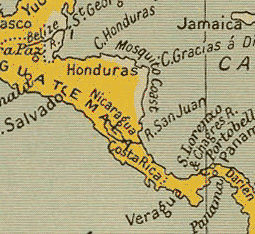 For a little over two centuries, the Miskito, a separate kingdom with its own monarch, would remain independent from Nicaragua. Over time, the Indian society lost its military coloration as Moravian missionaries from Bethlehem, PA, and American and British companies like Standard Fruit moved into the area. Along with the foreign companies and the missionaries came small businessmen-many of them Britons, Germans, and Americans-who settled in the interior of the Rio Coco. They settled into the region, married Indian women, and set up trading posts, ranches, boat yards, and lumber supply areas along the river. These people, called "bamboo whites" by the Marines, shipped raw wood from inside Nicaragua to sawmills located at Puerto Cabezas on the coast. Both politically and economically, they would prove critical in the war with Sandino.
For a little over two centuries, the Miskito, a separate kingdom with its own monarch, would remain independent from Nicaragua. Over time, the Indian society lost its military coloration as Moravian missionaries from Bethlehem, PA, and American and British companies like Standard Fruit moved into the area. Along with the foreign companies and the missionaries came small businessmen-many of them Britons, Germans, and Americans-who settled in the interior of the Rio Coco. They settled into the region, married Indian women, and set up trading posts, ranches, boat yards, and lumber supply areas along the river. These people, called "bamboo whites" by the Marines, shipped raw wood from inside Nicaragua to sawmills located at Puerto Cabezas on the coast. Both politically and economically, they would prove critical in the war with Sandino.
As a result of all these developments-missionary activity, the development of foreign owned "big businesses" along the coast, and the addition of a new strata of "bamboo businessmen" to the area's social structure-the Miskito remained more connected to the United States and the English-speaking Caribbean than to Hispanic Nicaragua. But if local history and economics pushed the coast in one direction, geopolitics moved it in another. Backed by pressure from the United States, Great Britain dropped the coast from protectorate status and officially ceded the area to Nicaragua in 1860. Since Nicaragua was too weak to exercise its claim, the coast remained in political limbo for decades until Nicaraguan President Jose Santos Zelaya sent troops into the area to capture Bluefields in 1894.
Despite military occupation by Spanish-speaking troops, the Indians continued to resent the Nicaraguans. The inhabitants of the coast also kept looking to Great Britain for support (several British and American businessmen did sell them arms). In 1894, the Miskito Reserve was dissolved — "reincorporated" into the Nicaraguan state — which led to a local uprising that was eventually quelled by the US Marines.
In the years following the 1894 takeover, Black Creoles and Miskito Indians would pepper the British Foreign Office with petitions that asked the British to retake their territory, a tradition that would continue until the late 1950s. This fraught relationship with the Nicaraguan government would lead to troubles well in to the 1980s.